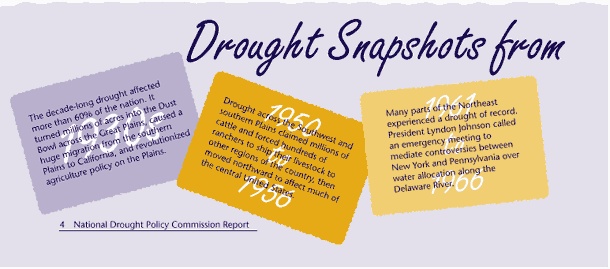|
|
| Return to Table of Contents |
|
DEFINING DROUGHT The definition of what drought is and what drought is not has profound implications for the environment and all segments of society, yet it may be different for each. Many attempts have been made to develop a comprehensive and meaningful definition. A generic definition provides a starting point: "Drought is a persistent and abnormal moisture deficiency having adverse impacts on vegetation, animals, or people." The public perceives "drought" as a serious departure from normal water conditions, a departure that requires a public response to reduce negative impacts. For that reason, public declarations of drought are often triggered by specific and well-defined conditions, such as a specific reservoir elevation on a specific date. In some cases, there are well-defined exit points that trigger a resumption of normal activity. These "drought triggers" become the practical definition of drought for a particular region and for specific issues. Defining these triggers is an inseparable part of planning for and responding to droughts. Once these triggers are defined, a region is much better able to estimate the costs, expected frequency, and risks of drought response. The Commission has found that in reality, drought is defined differently in different situations. For example, two months without rainfall during the growing season may result in serious drought conditions for farmers and homeowners in the eastern half of the country. The same dry period may be normal for those in the West, where water users may be more concerned with reservoir levels, which in turn are dependent on winter snow pack levels. In addition, the definition of what is drought has different functions depending on the goals to be achieved. For the purposes of planning and proactive mitigation, communities, business owners, and individuals need fact-based information that helps define strategies to lessen the potential impacts of drought. The declaration that "this is drought" triggers certain actions such as restrictions on the availability of water to users and activation of government response programs. National drought policy
must therefore define drought so that it meets the needs of diverse
water users and for diverse functions. It must be flexible enough to
include a variety of drought situations. It must also be specific enough
to distinguish between those situations that are true drought
emergencies and those that are normal cyclical conditions.
Return
to Table of Contents | (Next
Page) |
|
|

